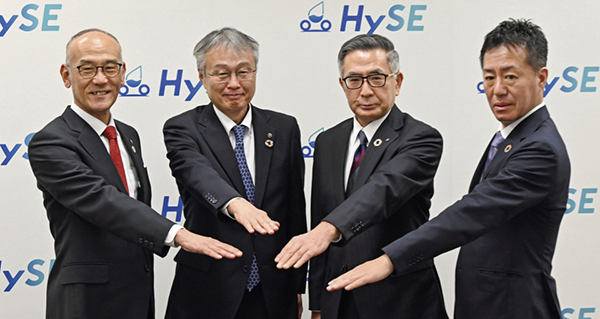Japanese 'Big Four' Join Forces on Hydrogen By Ben Purvis
Despite years of trying, there's still no clear solution to the packaging problems associated with building battery-powered motorcycles - particularly when it comes to high-performance or long-range machines - as even the best battery technology is still several orders of magnitude worse than gasoline when it comes to energy-density. As a result, companies are looking for other routes to the goal of carbon neutrality, and now Japan's 'Big Four' have joined forces to pursue the idea of hydrogen-fueled motorcycles.
Each company has a specific role to play in the project. Honda is concentrating on 'model-based' development of the hydrogen-powered engines themselves - i.e. computer simulations - while Suzuki is responsible for studying their functionality, performance and reliability. Meanwhile, Yamaha and Kawasaki Motors, which both already have experience of hydrogen combustion engines, are working on 'hands-on' research with real prototypes.
Yamaha is also tackling the difficult subject of developing a hydrogen refueling system and the hydrogen tanks that would be needed on 'small mobility' vehicles, including motorcycles. The four are being supported by two industry giants, Toyota and Kawasaki Heavy Industries, both with their own hydrogen infrastructure projects.
Kawasaki Motors has been the most outspoken of the Japanese 'Big Four' as an advocate of hydrogen combustion engines and had previously been working on the technology in partnership with Yamaha. Kawasaki has already shown designs for a hydrogen-fueled, supercharged four-cylinder sports-touring bike, using an engine derived from the 1000 cc four in its H2 model. A prototype for the engine has also been shown already, modified to include direct fuel injection. Both forced-induction and direct injection are essential in small, high-performance hydrogen-fueled combustion engines.
'working together on hydrogen-powered motorcycle engines'
The former because, while hydrogen is more energy-dense than petrol, weight-for-weight, it needs much more air in the mixture.
A turbo or supercharger compresses the air to get more into the cylinder. The direct injection is also vital, as it means the hydrogen can be added after the valves are closed without displacing air that's already in the combustion chamber. Yamaha has also been working on hydrogen combustion engines, developing a V8 that's used in a Toyota racing car in Japan.
Huge problems remain when it comes to making hydrogen a viable fuel for motorcycles. While it's carbon-neutral when it burns, with water being the main component of the exhaust, it's very energy-intensive to get hydrogen from water via electrolysis, and other forms of hydrogen come from processes that create their own pollution.
The storage and transport of hydrogen also poses significant problems, as it needs to be cryogenically stored at incredibly low temperatures to reach liquid form or placed under huge pressure to get a substantial amount into a tank. Even as a liquid, it's far less efficient, volumetrically, than petrol - you'd need a substantially larger fuel tank to get the same range, leading to weight and packaging problems that are not dissimilar to those faced by battery-powered electric bikes.
These are among the challenges facing the HySE project. Its chairman, Kenji Komatsu, who's also Executive Officer of Technical Research and Development at Yamaha Motor, said: "We are extremely pleased to announce the planned formation of the association. There are many challenges in the development of hydrogen-powered engines, but we hope to see the association's activities advance the fundamental research in order to meet those challenges.
"We are committed to this endeavor with a sense of mission to preserve the use of internal combustion engines, which epitomize the long-time efforts that our predecessors have invested."

